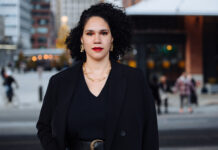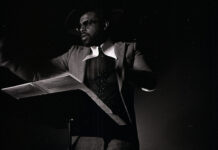“If you think about this he was one of the most important figures and has been in new music right up until his passing,” says classical violinist Leila Josefowicz when asked about composer Oliver Knussen. “He is beloved in the United Kingdom, because he lived there. In the United States people did know him for his visits to various orchestras, many of which I was with him.”
Friday night Josefowicz will perform Knussen’s Violin Concerto with the Los Angeles Philharmonic in the first of three concerts. Susanna Mälkki will conduct the performances (which also include Beethoven’s Third Symphony). On Tuesday the two women have curated a concert entitled A Tribute to Oliver Knussen. That concert will include three works by Knussen and four works by other composers: Colin Matthews, Helen Grime, Huw Watkins and Jonathan Harvey. Josefowicz will perform at that concert as well.
Over the weekend I spoke with Josefowicz about her passion for Knussen’s work and her professional relationship that lasted over twenty years. Below are edited excerpts from our conversation.
In a 1999 interview with Classic CD, Knussen said, “To me real music is real music when you’re not sitting around thinking it’s music – it actually takes you over.” When was the first time you remember feeling that way about his work?
The first time I heard his violin concerto because it was written right before I met him. I was about 20 when I met him. I was actually at a swimming pool on a lawn chair and I listened to it on headphones watching the score. I thought it was so incredible I jumped into the pool.
You’ve since performed his Violin Concerto over 30 times. How did your working relationship with Knussen afford you insight into this work and what he wanted to express with it?
His music is instantly recognizable if you know his language. It’s hard to describe different language, but it is detailed, precise and his use of color is just exquisite, though it’s not always pretty at all. The attention to detail is really incredible. I got to know him over 21 years. We had many performances and traveling around the world. It was a huge influence on my musical training, my perspective and my life.
Knussen said of the composition that “At times the violinist resembles a tightrope walker progressing along a decidedly unstable high wire strung across the span that separates the opening and closing sounds of the piece” Do you agree and, if so, how do you as that tightrope walker maintain your balance during the 17 minutes of the piece?
The beginning and the end and the transition between second and third movements is with the high E harmonics being held. This is sort of like this basic striking sound that is recognizable beginning, middle and end. The rest is a very suspenseful, expressive and, at times, sort of daredevil language. To make this as clear as possible is the key. You do a lot of things very precisely and very quickly. It’s like being a gymnast. He was a very precise man musically speaking and it definitely shows in the music.
When you and Susanna Mälkki were offered the chance to curate this tribute, what stood out as the priority for what you wanted an audience to understand about Knussen’s work and by extension your friend?
This is a very loving and respectful tribute to him. Susanna knew him. She visited his house with him. It’s an important gesture on our end to say this man is so important even if he is not here on this earth anymore. He is so important and was an inspiration for us.
He had all the qualities that you will hear in the music: incredible intelligence and wit, drama and suspense. He was one of the great great characters for sure in my life. One of the most influential people, not just for me, but for many people. I was especially close to him. It was hard for a long time to believe he wasn’t here. It was a shock. It’s therapeutic to pay tribute to him and this is very important to me.
On Tuesday we will have more of our interview with Leila Josefowicz where she will discuss her reasons for choosing new music and the advice she got early in her career about doing so.
Photo of Oliver Knussen and Leila Josefowicz by Rikimaru Hotta (Courtesy of LeilaJosefowicz.com)











